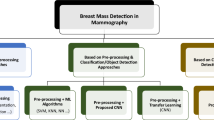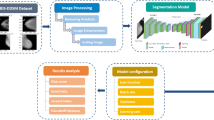Abstract
Deep Learning in healthcare immediately affects a person’s health and well-being. Deep Learning in medicine helps in early diagnosis. Medical data retrieval is time-consuming. According to a study, breast cancer is more common among women than men. Mammography is a frequent computer-assisted diagnosis of breast cancer. Mammography isn’t always accurate despite being widely used. Only 30% of breast cancers are detected early. In this post, we’ll look at the second step of preprocessing, which involves adding a filter to the image once it’s been split up. To enhance the appearance, breast-border-erasing filtering techniques are used for the data. The proposed segmentation approach subtracts two pictures after utilizing morphological procedures to restore the breast image’s boundaries. We found that employing homomorphic filters and a modified bi-level histogram to identify noise and boost contrast improved picture quality.
Access this chapter
Tax calculation will be finalised at checkout
Purchases are for personal use only
Similar content being viewed by others
References
Doppala, B.P., NagaMallik Raj, S., Stephen Neal Joshua, E., Thirupathi Rao, N.: Automatic determination of harassment in social network using machine learning. In: Saha, S.K., Pang, P.S., Bhattacharyya, D. (eds.) Smart Technologies in Data Science and Communication. LNNS, vol. 210, pp. 245–253. Springer, Singapore (2021). https://doi.org/10.1007/978-981-16-1773-7_20
Eali, S.N.J., Bhattacharyya, D., Nakka, T.R., Hong, S.: A novel approach in bio-medical image segmentation for analyzing brain cancer images with U-NET semantic segmentation and TPLD models using SVM. Traitement Du Signal 39(2), 419–430 (2022). https://doi.org/10.18280/ts.390203
Eali, S.N.J., et al.: Simulated studies on the performance of intelligent transportation system using vehicular networks. Int. J. Grid Distrib. Comput. 11(4), 27–36 (2018). https://doi.org/10.14257/ijgdc.2018.11.4.03
Joshua, E.S.N., Battacharyya, D., Doppala, B.P., Chakkravarthy, M.: Extensive statistical analysis on novel coronavirus: towards worldwide health using apache spark (2022). https://doi.org/10.1007/978-3-030-72752-9_8, www.scopus.com
Joshua, E.S.N., Bhattacharyya, D., Chakkravarthy, M.: Lung nodule semantic segmentation with bi-direction features using U-INET. J. Med. Pharm. Allied Sci. 10(5), 3494–3499 (2021). https://doi.org/10.22270/jmpas.V10I5.1454
Joshua, E.S.N., Bhattacharyya, D., Chakkravarthy, M., Kim, H.: Lung cancer classification using squeeze and excitation convolutional neural networks with grad cam++ class activation function. Traitement Du Signal 38(4), 1103–1112 (2021). https://doi.org/10.18280/ts.380421
Joshua, E.S.N., Chakkravarthy, M., Bhattacharyya, D.: Lung cancer detection using improvised grad-cam++ with 3D CNN class activation. In: Saha, S.K., Pang, P.S., Bhattacharyya, D. (eds.) Smart Technologies in Data Science and Communication. LNNS, vol. 210, pp. 55–69. Springer, Singapore (2021). https://doi.org/10.1007/978-981-16-1773-7_5
Joshua, E.S.N., Rao, N.T., Bhattacharyya, D.: Managing information security risk and internet of things (IoT) impact on challenges of medicinal problems with complex settings. In: Multi-Chaos Fractal and Multi-Fractional Artificial Intelligence of Different Complex Systems, pp. 291–310 (2022). https://doi.org/10.1016/B978-0-323-90032-4.00007-9, www.scopus.com
Joshua, E.S.N., Thirupathi Rao, N., Bhattacharyya, D.: The use of digital technologies in the response to SARS-2 CoV2–19 in the public health sector. In: Digital Innovation for Healthcare in COVID-19 Pandemic: Strategies and Solutions, pp. 391–418 (2022). https://doi.org/10.1016/B978-0-12-821318-6.00003-7, www.scopus.com
Rao, N.T., Neal Joshua, E.S., Bhattacharyya, D.: An extensive discussion on utilization of data security and big data models for resolving healthcare problems. In: Multi-Chaos, Fractal and Multi-Fractional Artificial Intelligence of Different Complex Systems, pp. 311–324 (2022). https://doi.org/10.1016/B978-0-323-90032-4.00001-8, www.scopus.com
Hazarikaand, M., Mahanta, L.B.: A new breast border extraction and contrast enhancement technique with digital mammogram images for improved detection of breast cancer. Asian Pacific J. Cancer Prev.: APJCP 19(8), 2141 (2018)
Ojala, T., Nappi, J., Nevalainen, O.: Accurate segmentation of the breast region from digitized mammograms. Comput. Med. Imaging Graph. 25, 47–59 (2011)
Chen, Z., Zwiggelaar, R.: Segmentation of the breast region with pectoral muscle removal in mammograms. Med. Image Underst. Anal. 71–76 (2010)
Ragupathy, U.S., Saranya, T.: Gabor wavelet-based detection of architectural distortion and mass in mammographic images and classification using adaptive neuro fuzzy inference system. Int. J. Comput. Appl. 46(22), 0975–8887 (2012)
Priya, D.S., Sarojini, B.: Breast cancer detection in mammogram images using region-growing and contour based segmentation techniques. Int. J. Comput. Organ. Trends 3(8), 54–57 (2013)
Ramirez-Villegas, J.F., Ramirez-Moreno, D.F.: Wavelet packet energy, Tsall is entropy and statistical parameterization for support vector-based and neural-based classification of mammographic regions. Neuro Comput. 77(1), 82–100 (2012)
Zhu, W., Xiang, X., Tran, T.D., Xie, X.: Adversarial deep structural networks for mammographic mass segmentation (2016), arXiv preprint arXiv:1612.05970
Liu, X., Tang, J.: Mass classification in mammograms using selected geometry and texture features, and a new SVM-based feature selection method. IEEE Syst. J. 8(3), 910–920 (2014)
Kooi, T., et al.: A comparison between a deep convolutional neural network and radiologists for classifying regions of interest in mammography. In: Tingberg, A., Lång, K., Timberg, P. (eds.) Breast Imaging. Lecture Notes in Computer Science, vol. 9699, pp. 51–56. Springer, Cham (2016). https://doi.org/10.1007/978-3-319-41546-8_7
Author information
Authors and Affiliations
Corresponding author
Editor information
Editors and Affiliations
Rights and permissions
Copyright information
© 2023 The Author(s), under exclusive license to Springer Nature Switzerland AG
About this paper
Cite this paper
Kumari, N.M.J., Rao, N.T., Bhattacharyya, D., Garg, L., Bhushan, M. (2023). Transfer Learning of Mammogram Images Using Morphological Bilateral Subtraction and Enhancement Filter. In: Garg, L., et al. Key Digital Trends Shaping the Future of Information and Management Science. ISMS 2022. Lecture Notes in Networks and Systems, vol 671. Springer, Cham. https://doi.org/10.1007/978-3-031-31153-6_4
Download citation
DOI: https://doi.org/10.1007/978-3-031-31153-6_4
Published:
Publisher Name: Springer, Cham
Print ISBN: 978-3-031-31152-9
Online ISBN: 978-3-031-31153-6
eBook Packages: Intelligent Technologies and RoboticsIntelligent Technologies and Robotics (R0)




